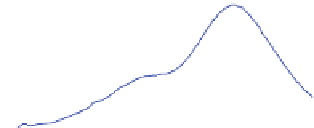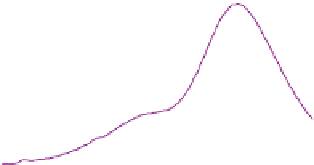Biomedical Engineering Reference
In-Depth Information
-
OOC
H
COO
-
H
EtOOC
NHCSNHR
25
R=
MA
-
OOC
H
H
COO
-
EtOOC
NHCSNHR
26
R=
FA
Fig. 25 Structure of racemic compounds 25 and 26
a
b
70
60
60
50
40
40
30
20
20
10
0
0
300
350
400
450
500
300
350
400
450
500
550
Wavelength (nm)
Wavelength (nm)
Fig. 26 The fluorescence spectra in DMSO (a) 25 + TMA fumarate and (b) 25 + TMA maleate
(
l
¼
290 nm)
exc
complex, and two molecules bind to the ligand. This complex does not induce changes
in conformation, and only minor modifications in fluorescence are noted. In conclusion,
compound 25 is able to distinguish between diastereoisomeric dicarboxylates (Fig.
26
),
and sensing properties are also observed even in the presence of 5% water.
In order to verify this proposal,
1
H NMR experiments were carried out which
clearly established that, in the complex formed between the host and TMA maleate,
the cyclohexane moiety adopts a boat-like conformation which places both naph-
thalene groups close together in the space (Fig.
27
).
Sensing experiments
in DMSO were also performed toward aliphatic
a
-dicarboxylates of different chain lengths [oxalate (DC2), malonate (DC3),
succinate (DC4), glutarate (DC5), and adipate (DC6)], all in the form of their
TMA salts [
47
]. Titration experiments, followed by
1
H NMR, UV and fluorescence
spectroscopy, led to the stoichiometry and complexation constants values shown in
Table
2
.
The 1:1 complexes formed with the larger dicarboxylates can be explained by
the complexation of each of the guest's carboxylate with one of the thiourea groups
in the ligand (Fig.
28
). Conversely, small dicarboxylates (i.e., oxalate) cannot be
accommodated in one host as the complexation of the first carboxylate places the
second one far away from the other thiourea group, and 1:2 complexes are a more
stable arrangement for this guest.
The fluorescence study resulted in more interesting differences. Thus, the fluo-
rescence spectra of ligand 25 resulting upon addition of increasing amounts of
TMA succinate and malonate exhibited a new band (around l
¼
490 nm), whose
intensity can be related to the formation of an excimer species similarly induced by
,
o
























































Search WWH ::

Custom Search